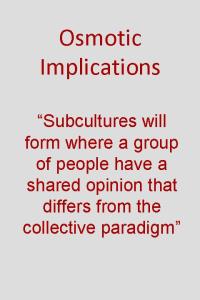Month: September 2012
The Subculture of Innovation
 Subcultures are often thought of in a corporate environment as evidence of fragmentation of the organization or a failing of management to impart a compelling collective vision. Some have argued that strong organizational cultures, where members agree and care about an organizations values, almost preclude the formation of subcultures[1]. There is significant evidence however, that even within the most successful organizational cultures there can exist, and sometimes must exist, strong subcultures in order to provide the mechanism for adaptation and change. In the same way that the innovative company creates change in the world, the innovative sub-culture creates change within a company.
Subcultures are often thought of in a corporate environment as evidence of fragmentation of the organization or a failing of management to impart a compelling collective vision. Some have argued that strong organizational cultures, where members agree and care about an organizations values, almost preclude the formation of subcultures[1]. There is significant evidence however, that even within the most successful organizational cultures there can exist, and sometimes must exist, strong subcultures in order to provide the mechanism for adaptation and change. In the same way that the innovative company creates change in the world, the innovative sub-culture creates change within a company.
The evidence for subcultures within your organization will be all around you. A few years ago I had an opportunity to meet with a large advertising agency and spent a few hours observing the differences between the very diverse people that can populate that industry. What struck me most were the well defined dress styles that each group adhered to in order to define themselves as being part of their own subculture. The creative tribe had their style (well pierced street fashion) and the business development tribe had their style (no tattoos, no jewellery, nice suits)and it was immediately obvious who was who. Returning to my office later in the day I could see the same tribal dress (with much reduced flamboyance) in the staff I spent most of my time with.
 In some instances companies rationalize subcultures as the price of doing business, “you can’t expect artists to wear suits” or “you have to supply programmers with mini refrigerators” are themes that we might be familiar with but which infer that subcultures are necessary but not ideal. Looking at some of the more diverse organizations however we often see examples of subcultures being nurtured, not just reluctantly accepted, maybe the most successful example would be Lockheed’s Skunk Works group. Can other large corporations learn from this?
In some instances companies rationalize subcultures as the price of doing business, “you can’t expect artists to wear suits” or “you have to supply programmers with mini refrigerators” are themes that we might be familiar with but which infer that subcultures are necessary but not ideal. Looking at some of the more diverse organizations however we often see examples of subcultures being nurtured, not just reluctantly accepted, maybe the most successful example would be Lockheed’s Skunk Works group. Can other large corporations learn from this?
Subcultures and Corporate Innovation
In most corporate environments innovation is not a priority for all employees. No matter how sensationally the “We are Innovative” PR machine spins, when pressed we all have to admit that an extremely large proportion of our collective time is spent maintaining the status quo. We all work in extremely competitive environments and to ignore the effort that is required just to avoid going backwards is an injustice on those who have this as their primary responsibility.
One concept we love at Osmotic Innovation is that corporate innovation is best done by those who choose it, rather than those conscripted. How this concept can manifest within the organization is the formation of ad-hoc innovation teams, matrix managed programs, skunkworks (in the adopted sense) and the many people from operations outside of formal innovation roles collectively bringing their ideas to life.
How then can the Osmotic Innovator use subcultures to support and nurture innovation within an organization? Rather than taking the direct (and somewhat ambitious) approach of trying to generate sub cultures themselves perhaps it is simply a matter of loosening up. Subcultures will form where a group of people have a shared opinion that differs from the collective paradigm. Where they flourish is in environments where they are allowed to express their differences, that is, where an organization lets them and encourages them to be different. Innovation as we mentioned earlier is by and large a fringe activity within most large organizations and so is an ideal activity to be the rallying point for sub culture formation. By loosening up some of the organizational cultural norms the Osmotic Innovator empowers the subculture to define itself and thus achieve in the light of day rather than in secret. Your innovators will identify themselves if you allow them to; just give them their own space, their own time or simply the freedom to dress themselves in the morning.
[1] Alicia Boisnier, Jennifer A. Chatman The Role of Subcultures in Agile Organizations. Accessed Sep 2012. http://www.hbs.edu/research/facpubs/workingpapers/papers2/0102/02-091.pdf
Here’s My Innovation, So Call Me, Maybe?
Hey, I just met you, And this is crazy, But here’s my number, So call me, maybe?
The era of Open Innovation appears to require any successful company delivering goods or services, particularly to the consumer segment, to find a way to utilize external ideas in their product development process – or to at least make an effort to appear to do so. The successes supposedly generated through Open Innovation (OI) are touted to customers, suppliers, potential partners, and even investors on the Street. Many companies go so far as to brand their OI to have it stand out further. (see Connect & Develop as one prominent example of branded OI)
One particularly big out-growth of OI is programs that seek to involve the wisdom of the crowd or to open firms up to ideas from individuals, rather than companies, outside the firm. This component of OI (let’s just call it Crowd Sourcing) requires a high degree of trust on the part of the collaborating partners – often small companies or individual inventors hoping that the company will respect their invention, work with them, and pay for their effort. This translates to large amounts of time spent by the companies evaluating ideas, providing feedback, and chasing imperfect leads so that the contributor feels valued and receives the desired follow-up call and feedback.
Too often this part of the process of OI is white-washed by the press and enthusiastic consultants looking to help you build your own system. The promise that every company can have its own ‘Connect & Develop” (P&G’s prototypical model of how to run an OI system) seems irresistible. To the press it’s a great story that connects with the everyman – ‘you too could get rich off your ideas!’ – but should the Osmotic Innovator put time into Crowd Sourcing or are external sourcing efforts better focused in other ways?
The Problems with Crowd Sourcing
– Technical Literacy: While it’s true, as Chesborough and many others argue, that the smartest people in the world don’t work inside your company that doesn’t mean that everyone is positioned to equally understand your business model, supply chain, and regulatory pressure. This means that a large volume of the ideas you’ll see from Crowd Sourcing ignore basic realities of the business you’re actually in or are obvious incremental developments with low value to the organization. Getting a real insight or connection you haven’t seen already if you’re running an efficient OI program is rare!
– Information Overload: The next problem with Crowd Sourcing is that once the gates are open and you start advertizing your willingness to pay for ideas you’ll be sorting through significant volumes of requests – trying to give each contributor an answer or feedback can become a job of its own, one with little return on the investment besides from a PR standpoint.
– Exposing Your Achilles Heel: Once you’ve created your Crowd Sourcing program in order to cut back on the noise and obvious ideas you can always put out specific technical challenges to properly direct those seeking to work with you. The balance that needs to be considered with this is that the more detail you provide on the real issues you are facing, the better the feedback, but the more your competitors can come to understand your weaknesses and potentially exploit them.
 The Benefits of Crowd Sourcing
The Benefits of Crowd Sourcing
– The Door is Open: There’s a well-known saying that begins, “when opportunity knocks . . .” that is very apt for a Crowd Sourcing program. Simply having the Crowd Sourcing program in place makes it easier for real opportunities to find you, perhaps before they find your competitor. A main point to having the Crowd Sourcing component of your OI program might well be argued to be as an advertising program for your R&D department.
– Wisdom of the Crowd: If you’ve ever watched the hit game show ‘Millionaire’ you know that having the crowd on your side can be a huge help. A volume of research also exists to prove that crowds do have a particular ‘wisdom’ that can direct decision making appropriately. Interfacing with the outside world has the benefit of allowing your innovation program to leverage the crowd.
– Perception: Its been mentioned briefly before, but it deserves its own mention – simply having a Crowd Sourcing as part of your OI program is visible proof to the market that you’re a modern company fully taking advantage of current thinking on innovation and R&D. As well, small and medium sized companies can see the Crowd Sourcing program as proof that your company is equipped to work with them.
It’s fairly obvious that there are downsides to running a Crowd Sourcing component of your innovation program, particularly the resource needed to fairly and appropriately respond to ideas. However, the author tends to find the arguments in favor of Crowd Sourcing to be compelling. In the modern R&D world, no company can expect to go it alone without extremely deep moats. Even with that kind of protection ignoring outside innovation and opportunity is a dangerous game. Having a Crowd Sourcing program, and advertizing its successes no matter how small, is invaluable in communicating with the outside world that you are truly open for business and innovation. The next time someone gives you their number be sure to pick up the phone, and call them, maybe.
Osmotic Innovation is Training Hard and Taking Time Off
Bernard Tyson explains why you must train harder and push yourself further than the competition to win the business Olympics. Take some of these lessons to heart and aim for the gold medal of your industry.
 Boost Creativity – Hire Social Rejects
Boost Creativity – Hire Social Rejects
As summarized in this post appearing on The Creativity Post blog three new studies seem to show that a positive correlation seems to exist between rejection or uniqueness and creativity. Indeed, it makes some sense as well that those unafraid of rejection are likely to share more creative or risky ideas. Does your organization tolerate rejects?
Take Time Off to Get More Done
In this post from Big Think the idea that idleness or down time is actually a boost to getting work done is tackled. The theory rests on the idea the productivity occurs in cycles and that trying to be too production is actually counter-productive. Unfortunately the 4 hour workday is not on the horizon.
